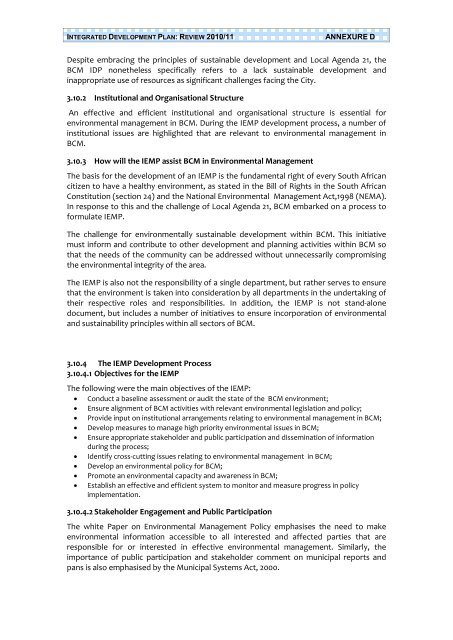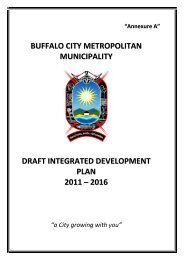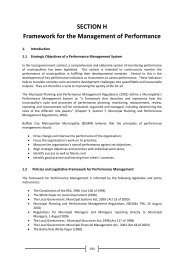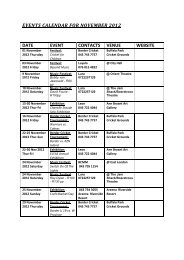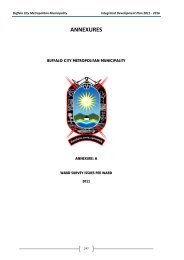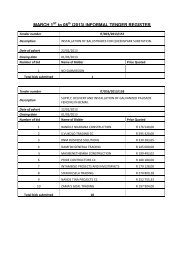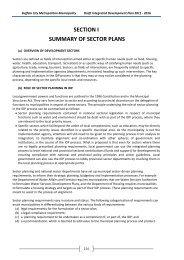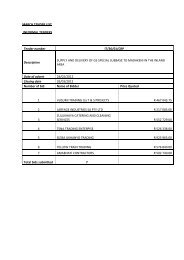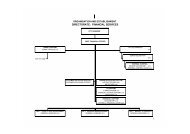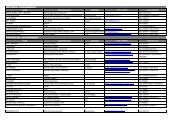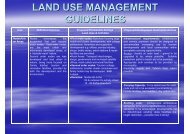annexure d executive summary of bcm sector plans - Buffalo City
annexure d executive summary of bcm sector plans - Buffalo City
annexure d executive summary of bcm sector plans - Buffalo City
Create successful ePaper yourself
Turn your PDF publications into a flip-book with our unique Google optimized e-Paper software.
INTEGRATED DEVELOPMENT PLAN: REVIEW 2010/11ANNEXURE DDespite embracing the principles <strong>of</strong> sustainable development and Local Agenda 21, theBCM IDP nonetheless specifically refers to a lack sustainable development andinappropriate use <strong>of</strong> resources as significant challenges facing the <strong>City</strong>.3.10.2 Institutional and Organisational StructureAn effective and efficient institutional and organisational structure is essential forenvironmental management in BCM. During the IEMP development process, a number <strong>of</strong>institutional issues are highlighted that are relevant to environmental management inBCM.3.10.3 How will the IEMP assist BCM in Environmental ManagementThe basis for the development <strong>of</strong> an IEMP is the fundamental right <strong>of</strong> every South Africancitizen to have a healthy environment, as stated in the Bill <strong>of</strong> Rights in the South AfricanConstitution (section 24) and the National Environmental Management Act,1998 (NEMA).In response to this and the challenge <strong>of</strong> Local Agenda 21, BCM embarked on a process t<strong>of</strong>ormulate IEMP.The challenge for environmentally sustainable development within BCM. This initiativemust inform and contribute to other development and planning activities within BCM sothat the needs <strong>of</strong> the community can be addressed without unnecessarily compromisingthe environmental integrity <strong>of</strong> the area.The IEMP is also not the responsibility <strong>of</strong> a single department, but rather serves to ensurethat the environment is taken into consideration by all departments in the undertaking <strong>of</strong>their respective roles and responsibilities. In addition, the IEMP is not stand-alonedocument, but includes a number <strong>of</strong> initiatives to ensure incorporation <strong>of</strong> environmentaland sustainability principles within all <strong>sector</strong>s <strong>of</strong> BCM.3.10.4 The IEMP Development Process3.10.4.1 Objectives for the IEMPThe following were the main objectives <strong>of</strong> the IEMP: Conduct a baseline assessment or audit the state <strong>of</strong> the BCM environment; Ensure alignment <strong>of</strong> BCM activities with relevant environmental legislation and policy; Provide input on institutional arrangements relating to environmental management in BCM; Develop measures to manage high priority environmental issues in BCM; Ensure appropriate stakeholder and public participation and dissemination <strong>of</strong> informationduring the process; Identify cross-cutting issues relating to environmental management in BCM; Develop an environmental policy for BCM; Promote an environmental capacity and awareness in BCM; Establish an effective and efficient system to monitor and measure progress in policyimplementation.3.10.4.2 Stakeholder Engagement and Public ParticipationThe white Paper on Environmental Management Policy emphasises the need to makeenvironmental information accessible to all interested and affected parties that areresponsible for or interested in effective environmental management. Similarly, theimportance <strong>of</strong> public participation and stakeholder comment on municipal reports andpans is also emphasised by the Municipal Systems Act, 2000.


